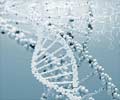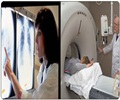Combination gene therapy delivered in lipid-based nanoparticles drastically reduces the number and size of human non-small cell lung cancer tumors in mice.
Combination gene therapy delivered in lipid-based nanoparticles drastically reduces the number and size of human non-small cell lung cancer tumors in mice, researchers at The University of Texas M. D. Anderson Cancer Center and the University of Texas Southwestern Medical Center report in the Jan. 15 edition of Cancer Research.
Two tumor-suppressing genes given intravenously reduced cancer separately but had their most powerful effect when administered together, cutting the number of tumors per mouse by 75 percent and the weight of tumors by 80 percent.'In cancer treatment we have combination chemotherapy, and we also combine different modes of therapy - surgery, radiation and chemotherapy. Now you've got the possibility of combined targeted gene therapy,' said Jack Roth, M.D., professor and chair of the M. D. Anderson Department of Thoracic and Cardiovascular Surgery and a senior researcher on the project.
The genes wrapped in the nanoparticles were p53, a well-known tumor suppressor that works by causing defective cells to commit suicide and is often shut down or defective in cancer cells, and FUS1, a tumor-suppressor discovered by the research group that is deficient in most human lung cancers. Each nanoparticle carried one of the two genes.
The Cancer Research paper reports that FUS1 works with p53 to force the lung cancer cells to kill themselves - a process known as apoptosis.
Further analysis showed that the combination achieved greater cell suicide because FUS1 suppresses a gene that expresses a protein known to rapidly degrade p53, says senior author Lin Ji, Ph.D., M. D. Anderson associate professor of thoracic and cardiovascular surgery.
The FUS1/p53 combination also activates a cell suicide pathway based in the cells' mitochondria, their energy powerhouse.
Advertisement
The nanoparticle delivery system, which the researchers have used for years, consists of a plasmid gene expression cassette loaded with DNA that encodes either the p53 or the FUS1 protein. This is wrapped tightly in a form of cholesterol to protect it from the body's defense mechanisms. 'You can't deliver naked DNA for cancer therapy,' Ji says.
Advertisement
Roth expects the research team to advance combination therapies to clinical trials in the coming years, either of genes or of genes with other biologic or chemotherapy agents.
'We certainly hope this approach will be more effective but we also think it's likely to be much less toxic, with fewer side effects, than other types of combined cancer therapy,' Roth says. 'These genes don't have much effect on normal tissue or normal cells when they are overexpressed. It's really just cancer cells where they seem to have their effect. Ultimately, the usefulness of this approach has to be proven in clinical trials.'
Source-Newswise
SRM











